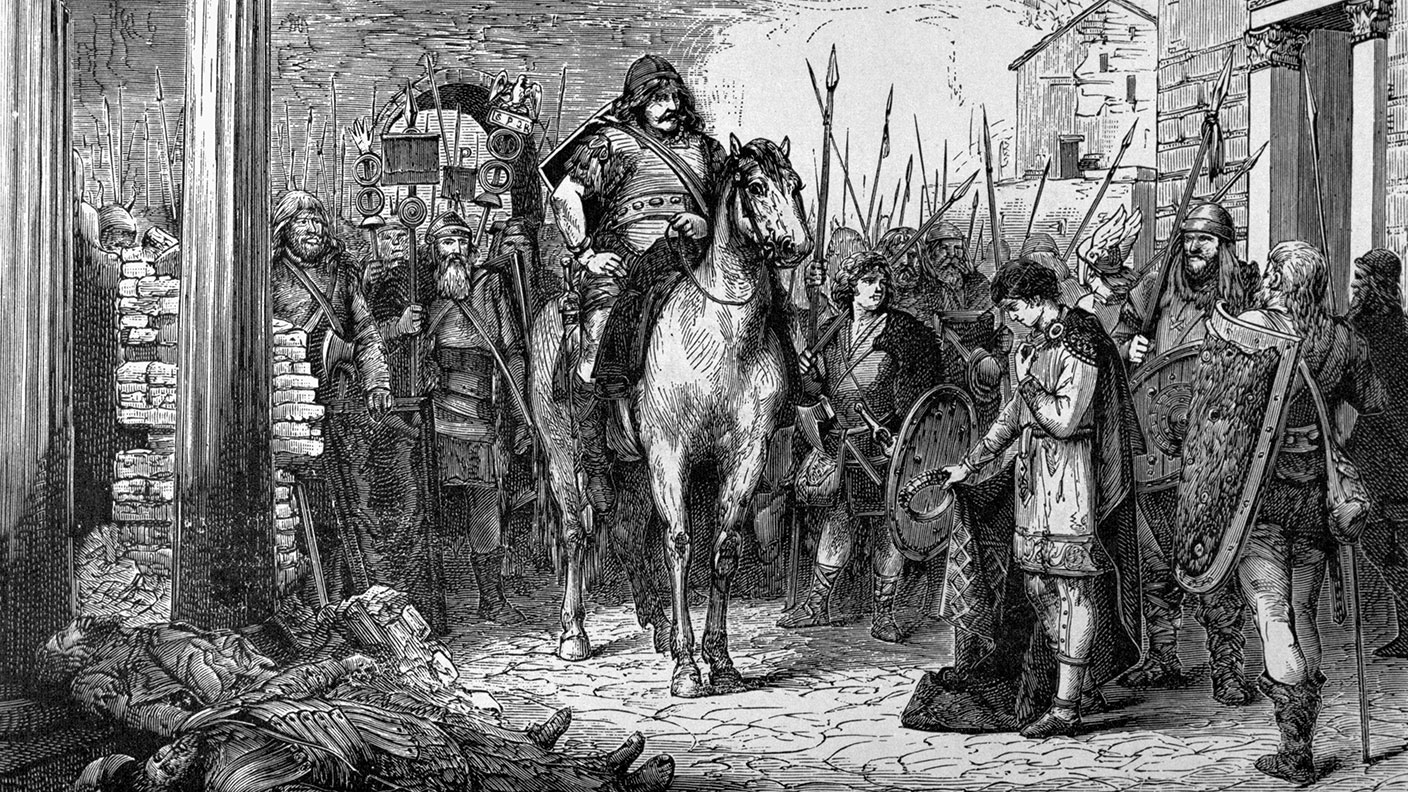4 September 476: the fall of the Roman Empire
On this day in September 476, the barbarian Odoacer deposed Rome’s last emperor, the teenage Romulus Augustulus.

As a pre-industrial society, the Roman Empire was not rich by modern standards. British economic historian Angus Maddison estimated that, even in central Italy, more prosperous than the rest of the empire, GDP per head was only around $800 (at 1990 prices). That's barely ahead of contemporary Burundi.
However, it's also roughly the same as medieval England, colonial America or Mao-era China – so, in historic terms, extremely prosperous. This wealth was a result of Rome's famously straight roads and its military dominance, which allowed trade to flow across the Mediterranean.
Pax Romana did not come cheap. About two-thirds of Roman taxes went on the armed forces. By the 300s, the model was coming unstuck as Germanic tribes migrated into the empire in huge numbers. Unable to fight off or bribe Goths, Huns and Vandals, the western empire gave them land. This eroded the tax base further, and when north Africa fell to the Vandals in 435, Rome lost Mediterranean dominance and access to some of its most productive farmland.
MoneyWeek
Subscribe to MoneyWeek today and get your first six magazine issues absolutely FREE

Sign up to Money Morning
Don't miss the latest investment and personal finances news, market analysis, plus money-saving tips with our free twice-daily newsletter
Don't miss the latest investment and personal finances news, market analysis, plus money-saving tips with our free twice-daily newsletter
The poverty of the Roman exchequer made the empire untenable. In September 476, the barbarian Odoacer deposed Rome's last emperor, the teenage Romulus Augustulus, capping a state of almost permanent crisis since the sack of Rome in 410. The empire fragmented into kingdoms that could not facilitate long-distance trade. This led to the return of subsistence agriculture, causing urban populations to collapse.
By 550 AD, Rome – once home to more than a million people – had a population of just 30,000.
Get the latest financial news, insights and expert analysis from our award-winning MoneyWeek team, to help you understand what really matters when it comes to your finances.
Alex is an investment writer who has been contributing to MoneyWeek since 2015. He has been the magazine’s markets editor since 2019.
Alex has a passion for demystifying the often arcane world of finance for a general readership. While financial media tends to focus compulsively on the latest trend, the best opportunities can lie forgotten elsewhere.
He is especially interested in European equities – where his fluent French helps him to cover the continent’s largest bourse – and emerging markets, where his experience living in Beijing, and conversational Chinese, prove useful.
Hailing from Leeds, he studied Philosophy, Politics and Economics at the University of Oxford. He also holds a Master of Public Health from the University of Manchester.
-
 ‘Why I have ditched my Help to Buy ISA for cash savings and the stock market’
‘Why I have ditched my Help to Buy ISA for cash savings and the stock market’Without the 25% bonus, my Help to Buy ISA is effectively redundant, says MoneyWeek writer Sam Walker.
-
 Is your inheritance tax allowance cut if you sell to downsize or sell your home to pay for care?
Is your inheritance tax allowance cut if you sell to downsize or sell your home to pay for care?Downsizing relief is a little-known benefit that could save your loved ones tens of thousands of pounds in inheritance tax after you’ve died.
-
 31 August 1957: the Federation of Malaya declares independence from the UK
31 August 1957: the Federation of Malaya declares independence from the UKFeatures On this day in 1957, after ten years of preparation, the Federation of Malaya became an independent nation.
-
 13 April 1960: the first satellite navigation system is launched
13 April 1960: the first satellite navigation system is launchedFeatures On this day in 1960, Nasa sent the Transit 1B satellite into orbit to provide positioning for the US Navy’s fleet of Polaris ballistic missile submarines.
-
 9 April 1838: National Gallery opens in Trafalgar Square
9 April 1838: National Gallery opens in Trafalgar SquareFeatures On this day in 1838, William Wilkins’ new National Gallery building in Trafalgar Square opened to the public.
-
3 March 1962: British Antarctic Territory is created
Features On this day in 1962, Britain formed the British Antarctic Territory administered from the Falkland Islands.
-
10 March 2000: the dotcom bubble peaks
Features Tech mania fanned by the dawning of the internet age inflated the dotcom bubble to maximum extent, on this day in 2000.
-
9 March 1776: Adam Smith publishes 'The Wealth of Nations'
Features On this day in 1776, Adam Smith, the “father of modern economics”, published his hugely influential book The Wealth of Nations.
-
 8 March 1817: the New York Stock Exchange is formed
8 March 1817: the New York Stock Exchange is formedFeatures On this day in 1817, a group of brokers moved out of a New York coffee house to form what would become the biggest stock exchange in the world.
-
7 March 1969: Queen Elizabeth II officially opens the Victoria Line
Features On this day in 1969, Queen Elizabeth II took only her second trip on the tube to officially open the underground’s newest line – the Victoria Line.